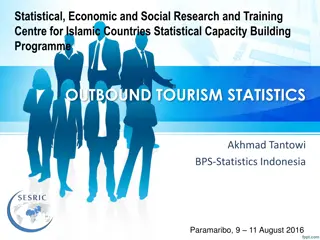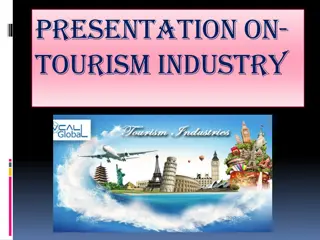Evolution of Strategic Management in Tourism: A New Paradigm
Explore the radical transformations in strategic management over the past 25 years, focusing on the New Strategic Theory and the Half Moon Bay Group initiatives. Discover how complexity, non-linearity, and fluidity guide the new emergent paradigm. Learn about the changes in approach to strategy and their adaptation to the tourism sector.
Download Presentation

Please find below an Image/Link to download the presentation.
The content on the website is provided AS IS for your information and personal use only. It may not be sold, licensed, or shared on other websites without obtaining consent from the author.If you encounter any issues during the download, it is possible that the publisher has removed the file from their server.
You are allowed to download the files provided on this website for personal or commercial use, subject to the condition that they are used lawfully. All files are the property of their respective owners.
The content on the website is provided AS IS for your information and personal use only. It may not be sold, licensed, or shared on other websites without obtaining consent from the author.
E N D
Presentation Transcript
3rd Edition Strategic Management In Tourism Edited by LUIZ MOUTINHO AND ALFONSO VARGAS S NCHEZ
CHAPTER 12 TOWARDS A NEW STRATEGIC PARADIGM RAFAEL ALBERTO P REZ AND ALEJANDRO P REZ-FERRANT
LEARNING OBJECTIVES Report on the more significant changes in approach to strategy over the past 25 years. Focus on the two re-foundation projects: the New Strategic Theory (NST) and the Half Moon Bay Group. Determine to what point we are faced with a new emergent paradigm of complexity, non-linearity and fluidity, guided by the NST. Raise awareness about the NST and its proposals and scope. Adapt these ideas to the tourism sector and verify how the complex ideas behind the NST correspond to the complexity of the world of tourism.
1 STRATEGIC MANAGEMENT IN TOURISM The central idea of this chapter is to inform readers as to how strategy has undergone radical transformations over the past 25 years and that we now possess an alternative strategic theory that has been conceived from a perspective of complexity, non-linearity and fluidity. While this is a general theory that is applicable to any context or sector, one could say it has been designed for the tourism sector. It is known as the New Strategic Theory (NST) and is the focus of this document.
2 1994: THE YEAR IN WHICH STRATEGY DIVERGED In 1994 emerge the three most significant critical works: The Death of Economics (P. Ormerod, 1994). The Rise and Fall of Strategic Planning (H. Minztberg, 1994). Strategy as a field of study: why search for a new paradigm (C.K. Prahalad and G. Hamel, 1994). Pandora's Box had been opened and reactions were not long in coming. Though not all of the receptive to criticism reacted equally. We can distinguish between the repairers, the inter- and trans-disciplinaries and the re-founders.
3 WHAT RE-FOUNDATION PROJECTS ARE WE TALKING ABOUT? The New Strategic Theory (NST) led by Rafael Alberto P rez that in 2001 propose a NEW STRATEGIC THEORY (NST) based in 7 changes. And 7 principles. The Half Moon Bay group of 31 experts led by Gary Hamel in 2008 to debate the future of strategic management that proposes 25 points of change.
3 The NST 7 CHANGES 1. In the central paradigm:from fragmentation to complexity. 2. In the subject:from rational actor to the relational human being. 3. In the organization:from production unit to network of innovation and meaning. 4. In the focus:from the science of conflict to the science of articulation. 5. In the study matrix: from a basis in economics to a basis in communication. 6. In the method:new tools. 7. In the methodology:new models.
WHAT HAPPENED TO NST AND WHERE IS TODAY? The Paradigm found: Experts from 11 countries expressed in Chile that the NST is the paradigm we have been looking for since Prahalad and Hamel (1994). Academic recognition: The NST has been the subject of seminars in more than 130 universities in 13 countries The New Strategic Theory apply Complexity to Communication and Strategy. I have done the reverse and applied Communication to Complexity , Edgar Morin. Empirical verification: The NST is being applied by Ministry for Employment and Social Security (Chile), for the eradication of child labour, and for the Ministry of National Defense (Colombia) for National Security.
TOURIST IS MUCH MORE THAN A ECONOMIC SECTOR IS HUMAN, RELATIONAL AND COMPLEX Tourism, besides being one of the world's most important economic sectors, is much more than a business in the way it influences, and contributes to, the construction, management and growth of populations, societies, the environment, politics, reputations, innovation and welfare Tourism is human and complex. Tourism is communication and innovation. Tourism is relational. Tourism is flexibility.
A COMPLEX TOURIST SECTOR WAS IN NEED OF AN EQUALLY COMPLEX STRATEGY THEORY SUCH AS NST. As long as Tourism was considered a business sector, approaches based on conventional strategies seemed to work perfectly. However, given that Tourism is today rather more than just business, the changes of the New Strategic Theory (NST) can provide a new type of approach of thought, of analysis, of action.
CONCLUSIONS The New Strategy Theory (NST) is considered, in the context of Latin America, the emergent paradigm that we were looking for since Prahalad and Hamel (1994) but less well-known in the English-speaking world. We have attempted to draw attention to the appearance of this New Strategic Theory (NST). A complexity approach that we consider to be particularly appropriate for tourism.























